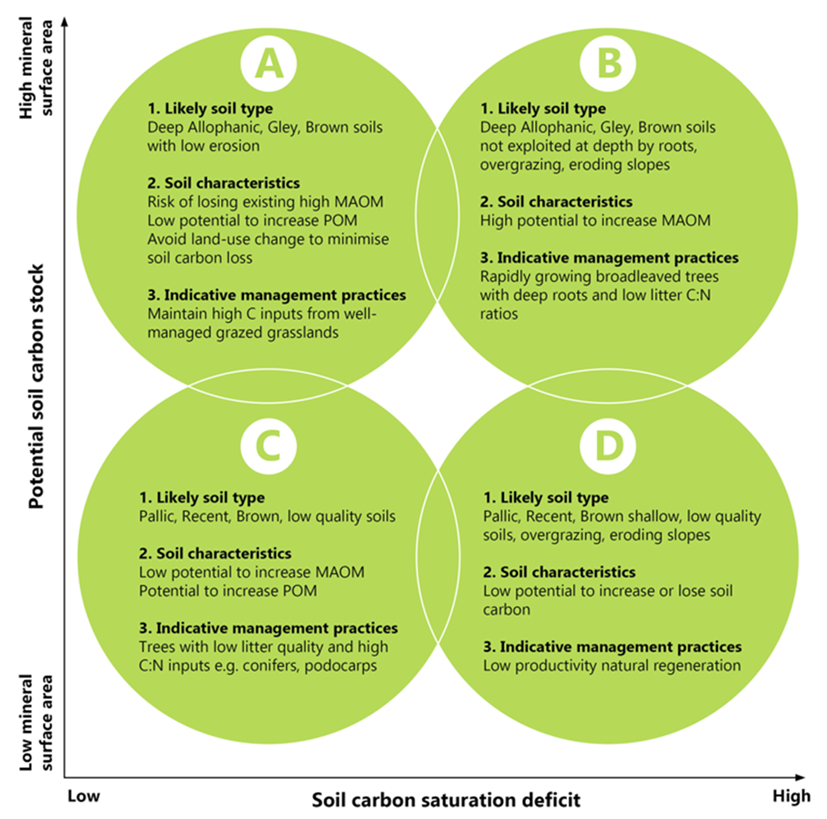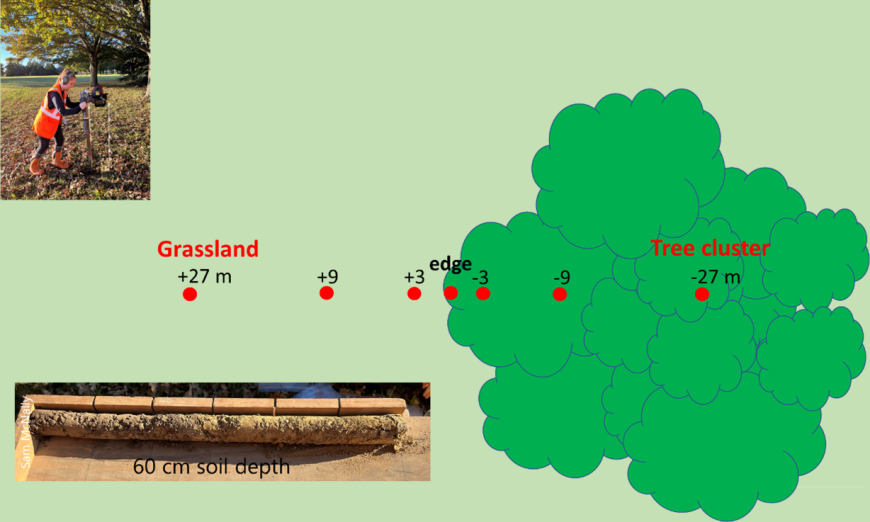Biomass and soil carbon stocks
In this section
Criteria for site selection
We have started the process to select 32 sites with established clusters of trees, with a variety of plant traits (conifers, broadleaves, native, exotic), in low to moderate sloping grasslands grazed by livestock (sheep and beef), across a range of soil and climate conditions. We will sample across sites that can be broadly classified into four categories in relation to the potential for soils to store more carbon and how close to saturation the soils are, as shown in the diagram. Soil type and properties are shown for each category and indicative management practices using clusters that could be used to maintain or increase both biomass and soil carbon stocks.

Fig. Rationale for site selection for the measurements
1. Soil types are based on the NZ classification
2. Potential for the characteristics to increase or lose carbon stocks (concentration x depth to 0.6m).
(POM - particulate organic matter, MAOM - mineral associated organic matter, C - carbon, N - nitrogen).
3. Indicative management practices using plants with specific traits to maintain or increase potential soil carbon stocks.
What kind of research sites are we hoping to locate?
There are specific research criteria that we need to adopt to ensure we can interpret the data on soil carbon stocks.
- What is a tree cluster? We are considering a tree cluster to be anything ~1 ha or less (currently not qualifying for carbon credits under the Emissions Trading Scheme). Shape of the planting is not important, but we would give priority to clusters 20 m across on the shortest axis.
- Historical land use – we’re interested in sites where trees have been planted or are regenerating within pasture. At this point we are not considering native remnants, as our research question focuses on the effect of introducing trees into grazing landscapes as a mitigation approach. Native remnants certainly hold great value for carbon and other ecosystem services, but they remain out of scope for the current research.
- Tree types – plantings of common exotics, both conifers and broadleaved, native tree plantings, low-input native regeneration. We are also interested in trees with alternative economic value, e.g. forage trees, nut trees. We would prioritize sites that have multiple tree clusters, representing several different tree types.
- Age of vegetation – plantings at least 7 years old. However, we emphasise planting rather than native regeneration, as we’re interested in the effect of introducing trees into grazed grasslands. We would also prioritize sites where the grass component is well established and no soil disturbance has occurred in >2 years (e.g. tillage, cultivation).
- Slope –priority to sites less than 15°, and no greater than 20°. Eroding slopes/depositional areas will challenge our measurement techniques, as these processes redistribute soil carbon, hindering our ability to capture the effect of trees on the soil. In addition to steep slopes, we exclude other systems where erosion/deposition of sediments is likely, such as riparian and gully plantings.
- Aspect – priority to sites that are not on south-facing slopes, as we do not want light limitation to influence our results.
- Elevation – priority to sites at elevations lower than 600 m
What we will be requesting from farmers/landowners?
We will request access to the site to collect approximately 30 soil samples, 4.5 cm diameter core to 60 cm depth, and measure vegetation (pasture biomass samples, non-destructive tree measurements).
We will request information on the site, including:
- Grazing intensity (e.g., stock class, grazing practice [continuous, rotational] How many grazing events per year with how many animals?)
- Fertiliser use
- Planting history (e.g., When were the trees planted? What is the approximate planting density, stems/ha? Are stock excluded from the trees?)
- Land use history (e.g., when was the most recent pasture renewal, cultivation? Was it ever used for crops? Have there been any other relevant soil disturbances?)
What can farmers/landowners expect from us?
Any data gathered on farms will be treated as confidential and reported only in aggregate form without identifying location data. We will ensure our sampling has no impact on farm operations (e.g., we will take proper farm biosecurity measures, refill holes created by soil sampling, and ensure that farm gates remain as we find them). We will also share research updates on the effect and benefits of trees on soil and biomass carbon stocks through informal reports and newsletters.


